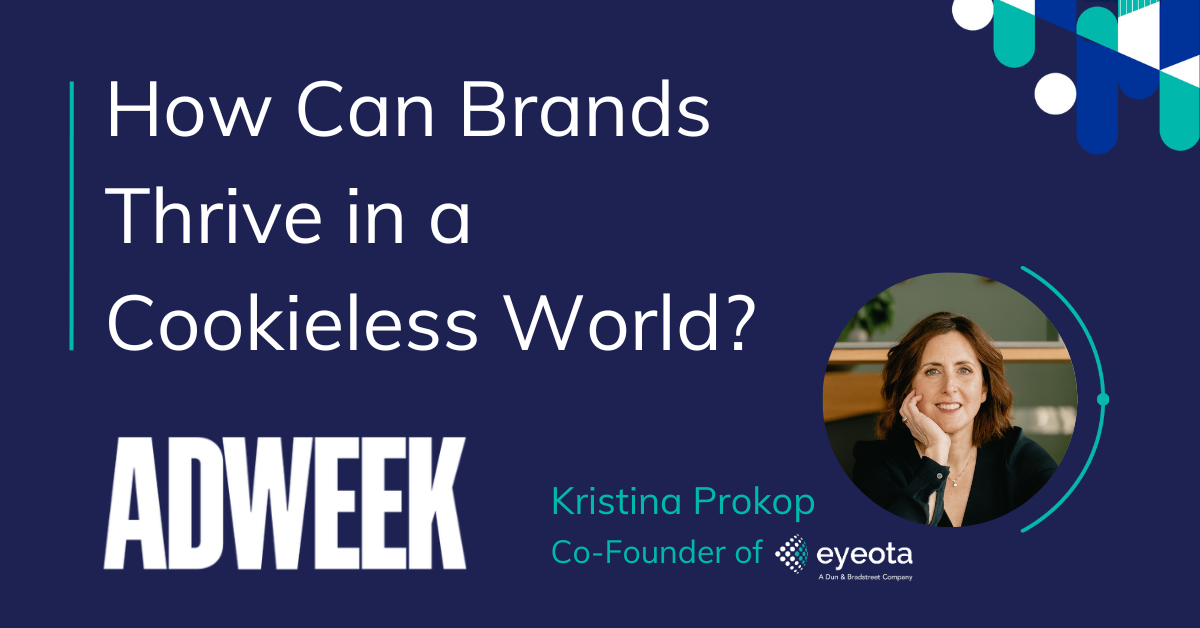GM of Digital Audiences at Dun & Bradstreet & Eyeota's Co-Founder, Kristina Prokop speaks to AdWeek to discuss how brands can thrive in a cookieless world. In this discussion, Kristina illustrates the insights needed to ensure marketers are prepared for the new reality, and the key points to keep in mind to ensure you're prepared for the shift in the industry.
Third-party cookie deprecation in Chrome is underway, and advertisers and publishers alike are looking to shore up their data-driven marketing strategies in a sustainable and effective way. One thing is certain: The end of third-party cookies does not mean the end of data-driven advertising.
Third-party cookies are not the only method for targeting digital consumers. There are multiple ways to identify users in privacy-compliant ways, from hashed emails to IP addresses to universal IDs, mobile IDs and more. Together, these sources unite to become sets of audience data that can enable omnichannel targeting. More than ever, marketers are going to need high-quality sources of such data to bridge the gap left by the loss of third-party cookies.
Programmatic digital display ad spending is poised to grow more than 15% worldwide this year. In particular, brands in the travel, retail, healthcare and pharma, automotive and entertainment industries will outpace the national digital ad spending growth rate. These brands expect their money to be put to good use in the context of larger omnichannel, cross-screen campaigns, regardless of the deprecation of cookies.
So, what solutions hold the greatest promise in that regard? And how can you tell if your business is equipped for this massive shift within the digital advertising and marketing landscape? When it comes to ensuring you’re prepared for advertising in a cookieless future, there are a few key points to keep in mind.
Data-driven marketing won’t slow down
Even as third-party cookies vanish from the digital landscape in 2024, third-party data remains an essential part of successful marketing and advertising. Working with quality-certified, reputable partners—ones that have navigated significant data-policy shifts in the past, such as GDPR—is imperative to continued success in a cookieless landscape.
Given the continued loss of legacy identifiers, including cookies, marketers face a significant challenge in tracking and targeting users across the online ecosystem. In this environment, relying on first-party data alone will limit targeting to existing customers and hinder personalized marketing efforts. High-quality third-party data offers a whole new opportunity for marketers by providing a broader and more comprehensive view of consumer behavior. These data sets can fill the gaps left by the absence of cookies, enabling businesses to better understand their target audience, optimize campaigns and deliver more personalized and relevant content.
Moreover, the increasing complexity of consumer journeys and the proliferation of digital touchpoints (including social channels and cookieless environments like connected TV and digital out-of-home) make it imperative for marketers to leverage third-party data for effective cross-channel targeting. In a world where users seamlessly transition between devices and platforms, the holistic view offered by high-quality third-party data allows marketers to create cohesive and consistent messaging strategies.
Third-party data’s ability to deliver personalized advertising for digital marketers is especially evident in areas like B2B, where buyers no longer distinguish between their personal and professional channels when it comes to the messages they receive. In many cases, social advertising—not just on LinkedIn, but across social networks—represents an underused vehicle for reaching B2B buyers. Across industries, third-party data can be used to greatly enhance the effectiveness of social advertising campaigns.
The future belongs to ID-agnostic players
There’s no single identifier that will emerge to replace third-party cookies within the digital ecosystem. The best way for advertisers and publishers to gain deeper audience insights is to embrace an ID-agnostic approach, along with technology and data partners that unite (rather than limit) the available identifiers within the ecosystem.
Universal IDs represent a transformative tool in the marketer’s arsenal, providing a means to overcome the challenges posed by evolving privacy regulations and the diminishing effectiveness of traditional tracking methods. By embracing universal IDs—along with other identifiers like mobile IDs, IP address IDs, hashed emails, contextual signals and more—and working with partners that approach these IDs in an agnostic and interoperable way, businesses can unlock a new era of precision targeting, seamless personalization and enhanced customer experiences.
Cookieless solutions in action
So, what does it look like when a robust cookieless targeting strategy comes together? IBM recently answered this question while on a quest to drive improved video campaign performance. Working with its agency, Eightbar, the brand used contextual-based B2B Predictive Audiences to achieve the most efficient cost-per-engaged-visit (CPEV).
As a part of this effort, Eightbar selected three types of targeting segments from different third-party data providers to test performance against its benchmark: B2B Predictive Audiences, powered by Proximic by Comscore and Eyeota, which enable media buyers to reach their desired audiences through AI-powered contextual signals, two competitor contextual segments and one competitor behavioral segment.
Eightbar ran a competitive evaluation testing the three targeting tactics, holding all other parameters constant, and measured video campaign performance of each targeting tactic-based on cost-per-engaged-visit. The B2B Predictive Audiences’ cost-per-engaged-visit was significantly below the client benchmark, 46% lower compared to competitive behavioral audiences, and 23% lower compared to competitive contextual segments.
Today’s advertisers and publishers need to be adjusting their strategies and tactics for a post-cookie world, and a variety of solutions have a role to play in the new reality. What’s most important, regardless of tactic or solution, is that advertising initiatives continue to be fueled by the most complete and highest quality data and insights possible. Established third-party data resources will continue to play an essential role in this regard.
If you want to ensure your data-driven marketing strategy is ready to greet the challenges and opportunities of 2024, Eyeota is here to help. Connect with Eyeota’s Data Desk team today!

